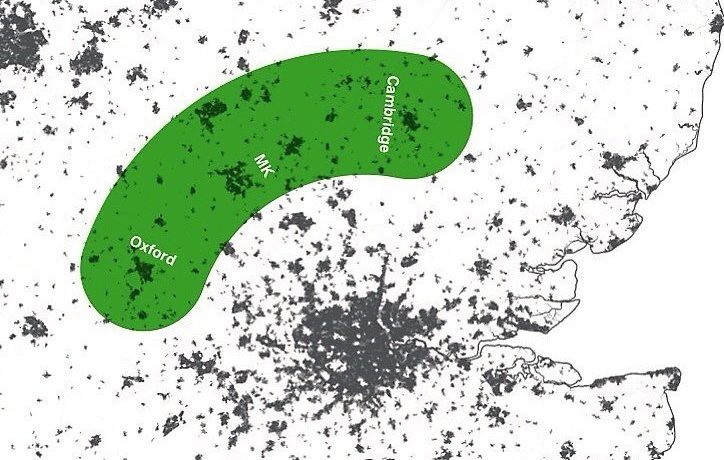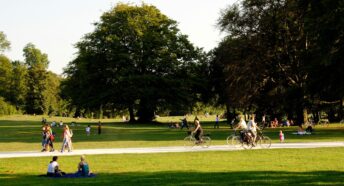Oxford-Cambridge (OxCam) Arc Update
As the Government now consults on its Vision for the Oxford-Cambridge (OxCam) Arc, is this a growth promotion project or a way of delivering a clean, green recovery? We fear the former, would love the latter. But what hope of taking on the vested interests? HAVE YOUR SAY!
The Government has now launched its consultation on the Vision for its proposed Spatial Framework for the OxCam Arc. The Arc comprises the five ceremonial counties of Buckinghamshire, Buckinghamshire, Northamptonshire, Bedfordshire and Cambridgeshire. The concept stems from a report by the National Infrastructure Commission (NIC) in 2017, entitled Partnering for Prosperity, which majored on ‘east-west infrastructure enabling new settlements’ and included proposals for 1 million new homes, East-West Rail, and the Oxford-Cambridge Expressway road scheme. The Government is preparing a Spatial Framework for the region to deliver economic, environmental and social benefits. They are now asking for our views on the ‘Vision’ for this Framework.
Visit the Government Placebuilder website to respond.
Consultation closes 12 October.
A copy of the CPRE consultation response will be available here in due course.
Meanwhile, here’s a few brief pointers from CPRE Buckinghamshire:
– The OxCam Arc proposals as currently envisaged by the National Infrastructure Commission (NIC), and endorsed by Government, represent an existential threat to the countryside and rural communities within the area, and risk undermining the economic prosperity that is being sought.
– We know development will come forward in the region over this time, so we agree it should be planned for and done well, including tackling our climate and nature emergencies.
– The level of development must be within the area’s environmental capacity and avoid/minimise/mitigate harm to our countryside and rural character, which underpin our economy.
– We think that’s best driven by local people, through their locally elected representatives, rather than top down imposition of targets.
– Regional scale infrastructure needs, such as transport and water, should be assessed from the aggregation of locally assessed needs and growth. Such infrastructure plans should take full account of environmental and social constraints and be subject to wide ranging and democratically based consultation and a thorough environmental assessment.
– We oppose the exaggerated top-down and damaging targets being promoted by the NIC and currently endorsed by the Government, as well as any attempt to railroad these through via the new OxCam Arc Growth Body.
– If the government is serious about its “levelling up” agenda then surely it should be investing in places where opportunity and quality of life are seriously lagging behind, rather than giving a further leg-up to areas that are already surging ahead.
Further Sources of Information
www.challengethearc.co.uk – a joint website for CPRE Branches across the Arc, with lots of background info & detail
STARC – the Stop the Arc group (previously the No Expressway Group) – see www.noexpressway.org – their press release below sets out a very comprehensive challenge to the current consultation
And last but very much not least…
National CPRE’s Spatial Planning Lead, Andrew Wood, explains his perspective on the consultation and how to make the best of engaging in it.
Since the NIC Report, the Expressway has been scrapped and the 1 million homes ambition appears to be fading – the Housing Minister refused to support it recently. That leaves East-West Rail, which is a good idea in principle but has caused controversy over the choice of route through Bedfordshire and Cambridgeshire. But if the Arc is to be more than a railway and a brand for boosting development, what should it be?
One word that was conspicuously absent from Partnering for Prosperity was “climate”. In February this year, government published a scoping paper for an Arc Spatial Framework, which struck a very different tone. Perhaps the most telling statement in that whole paper is this: “The Arc is …constrained by inadequate infrastructure, a stressed and fragmented natural environment, escalating housing costs, and complex local governance. It is at risk of worsening outcomes for the environment if we do not overcome constraints and meet future demands in the right way”. Or to paraphrase, the pressures of development and economic growth that are happening without strategic planning pose a serious threat to quality of life and to nature’s carrying capacity. That being the case, we should now expect a meaningful investment programme for nature and social wellbeing, shouldn’t we?
The Arc departs from the model of strategic planning that has been emerging for several years in Greater London, Greater Manchester and elsewhere, it doesn’t fit any existing administrative geography, and it’s unclear how the process will be made transparent and accountable, and not side-step the democratic scrutiny that comes through the Local Plans process. So we must seize the opportunity for influence, and this is the best stage of the process for us to set out our own priorities.
The Vision appears to agree with us on the big challenges: the environment is at risk, the climate emergency looms large, travel patterns are unsustainable, and homes are too expensive. What will the Spatial Framework really do about it? Here are my suggestions for four big ‘asks’.
- To have any prospect of meeting the net-zero 2050 carbon target, every single new economic enterprise which starts up or grows over this period needs to be a net reducer of emissions, and growth of existing businesses must also come with a carbon mission.
- The pressure on the area’s water environment must be a top priority that underpins all investment programmes. Natural systems and infrastructure are already operating beyond their limits. Pressure on chalk streams (Greater Cambridge Chalk Streams Project Report – Cambridge City Council), a world-class ecological asset, is a particular worry, and in the north-east of the Arc, the Cambridgeshire Fens are a fragile mix of wet, lowland habitats and the most productive farmland in the country. The Spatial Framework needs to set policies that can genuinely restore nature at every turn, not just trade it off against economic development.
- The transport priority should be making existing and new neighbourhoods walkable and more accessible by public transport – the 15-minute neighbourhood is a great model for this. (What is a 15-minute neighbourhood? | Healthy streets (smarttransport.org.uk)). Too many economic growth projects are still wedded to the 20th century model: build a road and allocate development land along it. There is no place for such outmoded thinking in a strategic plan for 2050.
- The housing priority should be to build genuinely affordable housing. Housing costs are a huge problem: if young families and key workers can’t afford homes, places don’t function properly. But this affordability crisis will not be solved by building open market housing, because it does not reduce prices. (Building the social homes we need | New Economics Foundation).
Downloads:
- Stop The Arc Group press release July 21 (6 download)
- Creating a Vision for the Oxford-Cambridge Arc (6 download)







